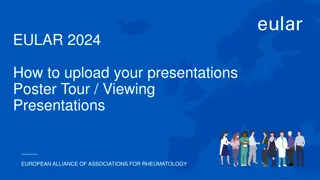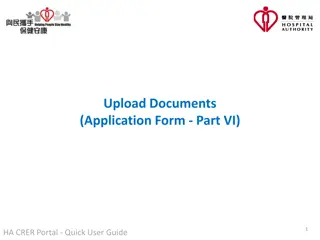Understanding HESA, Research Grants, and Funding Sources in Higher Education
HESA (Higher Education Statistics Agency) plays a crucial role in collecting, assuring, and disseminating data in higher education. This includes reporting on research grants, contracts, and the Frascati definition of research. The allocation of research income from various sources such as Research Councils, charities, government bodies, and industry is essential for universities. Clarification is provided on what constitutes research, including the exclusion of general research studentships. Monitoring and categorizing income from different sources, including competitive charities, is emphasized to ensure accurate financial reporting and funding allocation in the higher education sector.
Download Presentation

Please find below an Image/Link to download the presentation.
The content on the website is provided AS IS for your information and personal use only. It may not be sold, licensed, or shared on other websites without obtaining consent from the author. Download presentation by click this link. If you encounter any issues during the download, it is possible that the publisher has removed the file from their server.
E N D
Presentation Transcript
R&IS - HESA and HEBCI training December 2019
What is HESA? HESA (Higher Education Statistics Agency) collect, assure and disseminate HE data HE providers have a statutory requirement to report data to HE funding and regulatory bodies Table 5 Research grants and contracts breakdown by source of income and HESA cost centre Research income - should conform to the conventions of the Frascati definition of research
Frascati definition of research https://warwick.ac.uk/services/ris/systems/dataquality/frascati Research and experimental development (R&D) comprise creative work undertaken on a systematic basis in order to increase the stock of knowledge, including knowledge of man, culture and society, and the use of this stock of knowledge to devise new applications. Includes: Basic research, Applied research, Experimental development; Should have an element of novelty and the resolution of scientific and/or technological uncertainty ; Does not include: routine testing and analysis of materials, components, products, processes, etc; feasibility studies; routine software development; general purpose data collection; Most reporting based on Research only (as recorded under Activity Type in Ideate)
Studentships As per the HESA definition research does not include General research studentships Table 5 should include all research grants and contracts income (including tuition fees for research studentships and fellowships) associated with the contract. Grants for research studentships or fellowships that are associated with a research grant or contract should be returned under the same column as the grant or contract. Stand alone studentship awards - NOT research (record in Ideate as Related related and Studentship = Yes ; Some elements of studentships can be counted as research if associated with a grant or contract (record in Ideate as Research and Studentship = No .
Source of Income 1. Research Councils (incl Royal Society, British Academy) 2. UK-based charities (open competitive process) 3. UK-based charities (other) 4. UK central government bodies/local, health and hospital authorities 5. UK central government tax credits 6. UK industry, commerce and public corporations 7. UK Other sources 8. EU government bodies 9. EU-based charities (open competitive process) 10. EU industry, commerce and public corporations 11. EU (excluding UK) other 12. Non-EU-based charities (open competitive process) 13. Non-EU industry, commerce and public corporations 14. Non-EU other
Competitive Charities The correct recording of Competitive Charities is key: The University receives a top up from the Government for eligible charity research income via QR funding The split of Charities Competitive / Non-competitive research income is relevant to REF metrics. HESA definition There should be evidence that a particular income stream or grant was available to more than one HEP through direct competition. This should be within a process where no credible candidate was excluded, and the income awarded to the HEP which demonstrated the highest quality research proposal according to external peer review. To be eligible the funding must be from a registered charity, delivered through an openly competitive process and subject to external peer review in the award process.
Funder records in Ideate Evidence of competitive charities Any changes to HESA category over time Credit check information Due diligence check information
Frequently seen issues Competitive Charities Industry UK / EU / Overseas - income received from a multinational company should be coded depending on the location of the office making the award, e.g. a multinational with a French subsidiary making the award would be coded as EU. EU / Overseas Switzerland, Norway and Leichenstein are Overseas
Collaborators / Sub-contractors / Partners It is the nature of the relationship that determines whether the research income can be counted: Collaborator the University is in collaboration with a party at application and assuming a share of academic, legal and financial responsibility this can NOT be included in research income in the University s accounts. e.g. collaboration on an RCUK grant. Sub-Contactor - if a party is acting in the capacity of a subcontractor, where the University would hold the balance of control, risk and responsibility this CAN be included in research income in the University s accounts. e.g. buying in a survey/service on a project. Partner the University is working in partnership with a party who supply some input to the research, often in terms of an in-kind contribution e.g. industrial company providing some equipment for use
Collaborators / Sub-contractors / Partners Some questions can help to determine the nature of the relationship such that the research income can be counted or not: Where is the balance of risk in the project? Which parties were named in the agreement? Who is in control of how the work is done? Who does the funder believe they are engaging with? Are we acting purely as a banker? Who are the key members of staff on the project? Are decisions made by the University acting alone or via a steering group?
Collaborators / Sub-contractors / Partners The nature of the relationship affects whether the research income can be counted, which affects how we record the budget in Ideate: Collaborators Ideate does NOT include collaborators budget in fEC / Price Sub-Contractors Ideate DOES include sub-contractors budget in fEC / Price Important to record any external parties and the nature of the relationship for HESA and other reporting (e.g. international relationships, industrial partnerships) Partners Ideate does NOT include partners budget in fEC / Price
HEBCI Higher Education Business and Community Interaction Survey
HEBCI Data collected from 1999 onwards World s longest running dataset on University business interactions Voluntary and organised by HEFCE to @2008 Compulsory and organised by HESA 2008-09 onwards Collects financial and output data (proxy measures) on Knowledge Exchange
HEBCI Why? Compulsory submission as part of annual HESA submission (@ Dec) Data on Collaborative and Contract Research used to determine institutional HEIF allocations, currently @ 4.2m pa. Value as management information (internal) and for planning (Research England)
HEBCI - Validation For 2018-19 a dataset of 2,480 entries Income of 137,821,549.48 NOT all are eligible! 1428 NOT eligible, 1052 are! 809 New Projects for 2018-19 HEBCI Coding CHECKED many times: in-year review; end of year review; analysis review; FO Review (many times). To UEB ->GFD ->HESA ->Variance Checks (multiple)
Dont Panic! You are doing a great job! The data are (and will continue to be) checked on a regular basis A series of FURTHER data checks are ALWAYS undertaken in the Autumn of each year In some cases classification is an Art rather than a Science!
HEBCI Refresher Collaborative Contract research Exclude neither of above
Collaborative research involving public funding Grant-in-aid from at least one public body, and Material contribution (which may be cash or 'in-kind' if specified in the collaborative agreement and auditable) from at least one external non-academic collaborator. The term 'non-academic organisation (collaborator)' should be understood to refer to charities, public and not-for-profit organisations as well as commercial business. For example Knowledge Transfer Partnership (KTP): Other UK Government departments (Category 2)
HEBCI Collaborative Categories: 1 BIS RC 2 Other UK Government 3 EU Government 4 Other Use same code for public sponsorship and collaboration split determined via HESA category
Contract Research Must be identifiable as meeting the specific research needs of external partners. Must be either Collaborative, Contract or Excluded. Basic research council grants should not be returned as contract research. Contract Research sub-categories: SMEs (category 5) non-SME Commercial (Category 6) non-Commercial (Category 7)
SMEs SMEs are classified as enterprises which: employ fewer than 250 employees worldwide (including partners and executive directors), and has either an annual turnover not exceeding 50m euros, or an annual balance sheet total not exceeding 43m euros, and conforms to the following independence criteria: An enterprise is considered independent unless 25% or more of the capital or of the voting rights is owned by an enterprise falling outside the definition of an SME whichever may apply, or jointly by several such enterprises. (This ceiling may be exceeded if the enterprise is held by public investment corporations, venture capital companies or organisational investors, provided no control is exercised either individually or jointly, or if the capital is spread in such a way that it is not possible to determine by whom it is held).
Some examples BBSRC Project, Research and profile previous BBSRC grants and their effectiveness and recommend improvements to impact of funding (Category 7, Non-Commercial) BBSRC Project, Mapping a genome (Category 8, Exclude) Charity is contracting research for its own purposes (Category 7, Non-Commercial) Agriculture and Horticulture Development Board (AHDB): Statutory Levy Board; NOT Government Funded; Board with Government Appointees; Sub-Sector Boards Category 7, Non-Commercial
HEBCI Contract Research Define meeting the specific research needs of external partners Categories: 5 SMEs need to be very careful here 6 non-SME commercial 7 non-commercial























